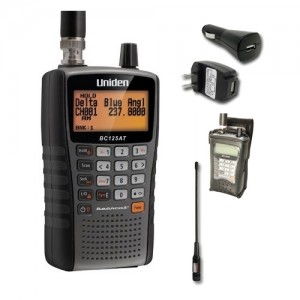Until recently most handheld scanners came with an AC wall charger/power supply and some even came with mobile power cords for the car. Newer models these days often do not. Why is that? Is Uniden or the others trying to save a buck here and there? Is there a conspiracy to sell more chargers?
Well, the answer is complicated and there are a couple reasons involved. The most important is that the various manufacturers are switching many portable devices, including scanners, to charge off of common USB devices. Since many different devices are going this route, like cell phones, headsets and others, scanner manufacturers are following suit. This lets consumers use a single charger with many devices. This is a good thing! Sure, scanner makers might save a buck or two here but so will you.
Another reason is regulatory. Some states have set up rules to govern consumer electronic devices including scanners and cell phones; USB charging is one way to comply with these rules.
By using USB to charge or power your scanner you can use any of the several chargers you likely already have at home. If you are reading this you almost certainly already have a USB charger. Don’t think so? How about the computer? If it has a USB port chances are it will charge your scanner just fine. Got a cell phone or tablet? Chances are it comes with a USB charger. The cable may be different but the USB charger will probably work with the scanner.
Newer scanners with USB usually come with the USB cable. This is used for both programming and charging. Older Uniden scanners, like the BCD396XT, have serial ports instead of USB and have non-USB charging ports. GRE & Whistler built scanners have either a direct USB port (like on the WS-1095) or serial ports (such as the older PSR500/PSR600)
The USB cable that comes with most scanners is called the “USB-Mini”, most newer non-Apple cell phones and cell phone accessories use the “USB-Micro”. You can usually use any USB-Mini cable for the scanner so there is a good chance you already have some lying around. Leave one in the glove box to charge the scanner in the car and another in the camera bag. ScannerMaster sells replacement cables as well.
Another thing to remember is that handheld scanners will generally NOT charge the battery while the radio is turned on. USB has limits as to the power available so if you need to charge the batteries turn the radio off. USB will power the radio if the batteries are dead or missing but it cannot power and charge at the same time.
If you don’t already have a spare USB charger and cable or two lying around ScannerMaster sells them for both the house and the car. You can also use external battery chargers; these tend to charge faster than charging in the radio. (AC Adaptors) (Mobile Adaptors)
Also remember that while most handheld scanners these days use AA batteries you cannot charge Alkaline cells. Do not try to charge alakalines. They tend to leak, burn or do other nasty things that can destroy your radio and melt your brain if you try to charge them.
One more note to remember: Base/mobile scanners that have USB ports but that do NOT run on batteries (like the BCD996P2 or BCD536HP) cannot be powered by USB, they need their included AC adaptor or some other source of 12 volts DC. These scanners use the USB port for computer access only.




